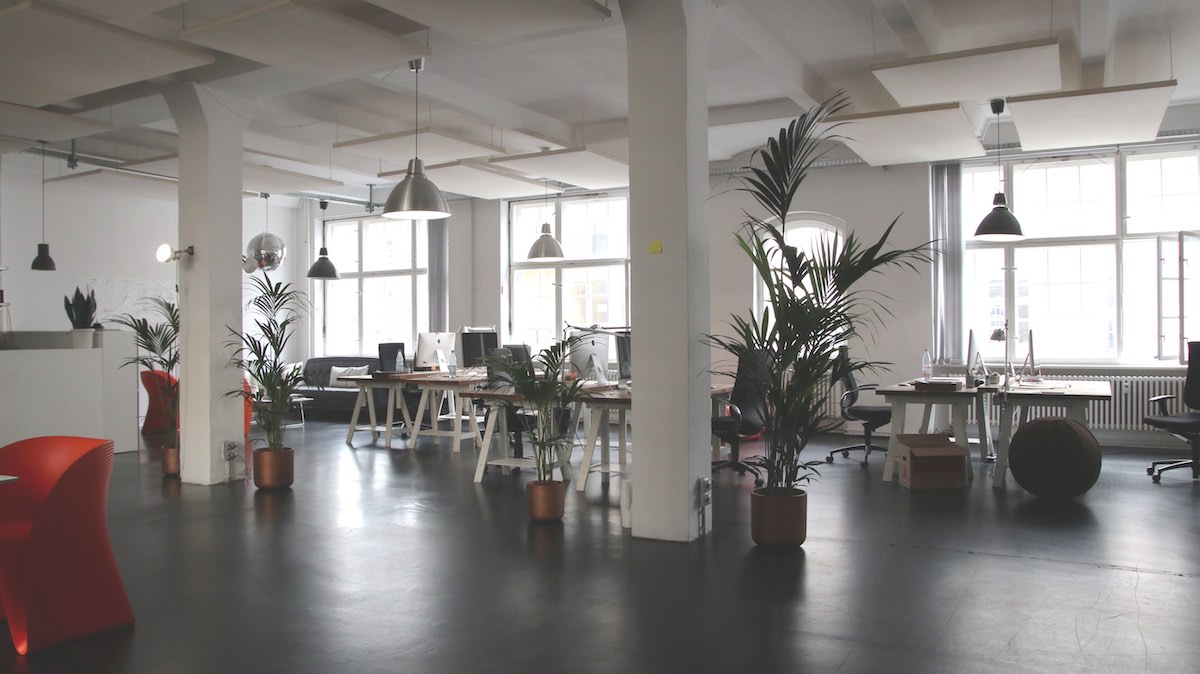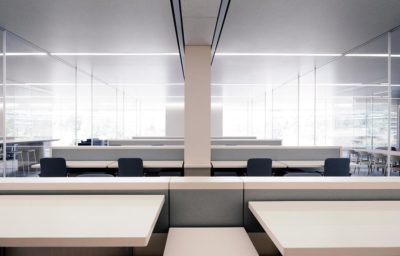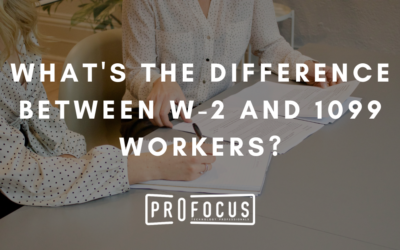Apple is almost ready with their giant new “spaceship” campus….you know, the one that looks like a giant flying saucer from the 1950s?
It’s definitely an impressive looking building. Yet I came across this article, and it appears that some Apple employees are not big fans of this new office space.
It features an open office environment with long benches where employees will sit, side by side. There are no partitions or walls separating each individual workstation and there’s not much in the way of privacy. In fact, it looks a lot like what a corporate office inside the Borg empire would look like, doesn’t it?
I can attest to the fact that this kind of office environment is quite noisy. I’ve personally worked in this kind of workbench arrangement, and voices and noise travel quite far in this type of work environment. It’s almost a necessity that you use headphones to tune out ambient background noise and voices.
There’s a vocal group of employees at Apple who are definitely not happy with this new office architecture.
They’ve been used to private, closed-door offices, or at the very least, cubicle environments with high wall partitions. Cubicles have traditionally been a common way of divvying up office floor space for employees.
But lately, many companies have eschewed the traditional cubicle office layout. Partly because it probably saves time and money setting up long tables or workbenches versus setting up cubicle walls and partitions.
The additional benefit is it allows companies to easily move and relocate employees, when necessary. Especially if employees are issued laptops or tablet devices. All an employee has to do is move their laptop or tablet to a different workstation, plug into the external monitors, which stay immobile in their original locations, and voila, you’re instantly relocated to a different physical location.
Disadvantages of Open Office Spaces
It’s not hard to imagine why some of the employees at Apple are unhappy with their new office environment. Given a choice between a nice, private closed-door office, or at the very least, high wall cubicles, and a completely open environment where there are no partitions between you and your fellow coworkers, is it any wonder there’s been lots of grumbling and complaints from employees?
As a software developer, the one skill valued by our employer is the ability to sit down, hunched over a keyboard, and start pounding away new computer code.
And in order to do that, a developer really needs a lot of concentration. In fact, it’s been said writing computer code really requires one to get into a sort of “zone” mental state.
Many developers find listening to music or podcasts a useful mental aid which helps with concentration.
But most of all, it requires a QUIET ATMOSPHERE. That means no loud or ambient noises. And that includes conversations between others standing or sitting near you.
Trust me when I say even the smallest interruptions can break your train of thought when you’re busy writing code. It can almost feel like being woken up from a trance.
The “zone” is where every developer feels most productive. Your brain is in a mode where all you’re thinking about is the problem at hand. It almost feels like your hands typing on the keyboard are an extension of your brain.
I’ve been in several open office environments, and noise is the biggest problem. I suppose you can try doing things to the architecture of the building space, like attempting to dampen the way sound travels, but it’s not cheap designing for that kind of environment. And then it defeats the purpose of cost cutting, which is a primary motivator behind these open offices in the first place.
I’ve yet to meet a developer who PREFERS these open office environments. They’ll take a closed-door office or high wall cubicle, given the choice.
So if these kind of open office environments are so unpopular, who came up with the bright idea of creating them in the first place? Besides the cost-cutting aspect of being able to squeeze more employees into the same office space, are there any real tangible benefits for the actual employees?
I personally find a lot of problems with the completely open office plan. The noise and distractions are a real hindrance to concentration. Sure, putting on headphones might help, but for some developers, listening to music or podcasts are a distraction in and of itself.
Yet the open office plan does try to address a shortcoming with closed-door offices or high cubicle walls.
The Closed-Door Problem
As much as those kinds of workspaces help to promote quiet environments, it creates a different kind of problem.
It discourages the act of collaboration and communication. When you’re ensconced inside an office or a private cubicle, you’re obviously not communicating with or working with others.
Yes, the actual act of coding in front of a computer requires isolation and a quiet environment, but software development isn’t just about coding. It’s actually the smallest piece of software development.
Coding is the LAST piece of software development. To even to get to the point where a developer has enough knowledge to know what to code, a developer needs to communicate with the business stakeholders of the project, the project manager, the product owner, the business analyst, whoever is the business person initiating the project requirements.
An application rarely lives in isolation. It’s composed of many elements… a networked environment, a database environment, web servers, external enterprise components. You often have to work with other folks on your team or in other departments of your organization to ensure your application can integrate successfully with all these external components.
Then, of course, there are your fellow developer colleagues, whom you will most likely need to work directly with, as you’ll often be codeveloping your application with them.
All this interaction requires face to face communication. And sitting in isolated, offices behind closed doors discourages that from happening. Especially in this day and age where agile development is replacing traditional waterfall development. Agile is all about open collaboration and communication, which is probably the catalyst behind the open office movement.
The Future of Office Design?
So if closed doors and cubicle walls discourage collaboration and completely open office environments make it hard for developers to concentrate when it’s time to code, what IS the answer?
I think we’ll eventually see an evolution that melds the two office environments.
Perhaps a sort of “bullpen area” where low-wall cubicle partitions are grouped together, so that a team consisting of software developers and business stakeholders sit together, but surrounded by high cubicle walls that cordon off the entire bullpen area.
When a developer needs the isolation, they have enough privacy to work at their own workstation, but when the time comes for collaboration, you’re sitting close enough to your fellow developers and business stakeholders to hold impromptu meetings. You could even create a small “huddle” area where you can hold impromptu meetings with the team.
Any takers? I, for one, wouldn’t mind this kind of evolved office environment … you’d be surprised just how loud sound carries when your fellow developer on that open workbench is munching on Cheetos.





